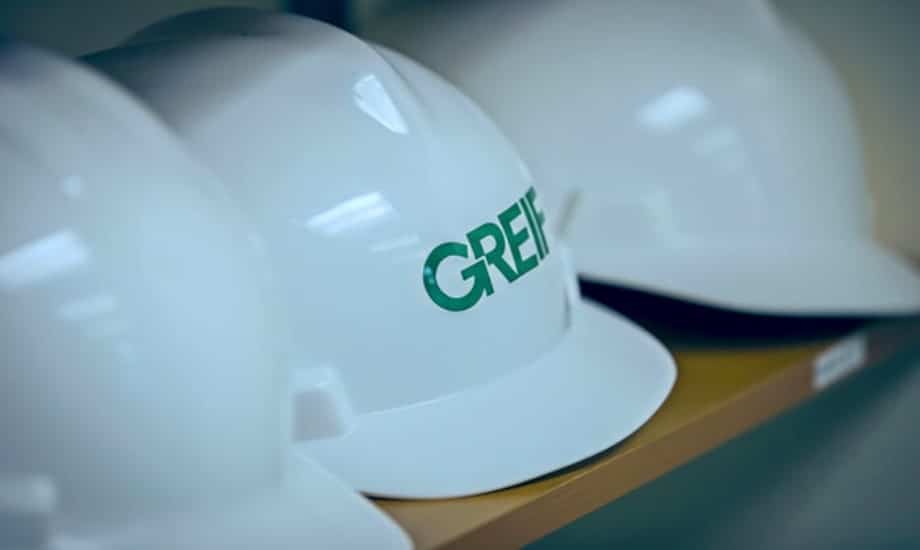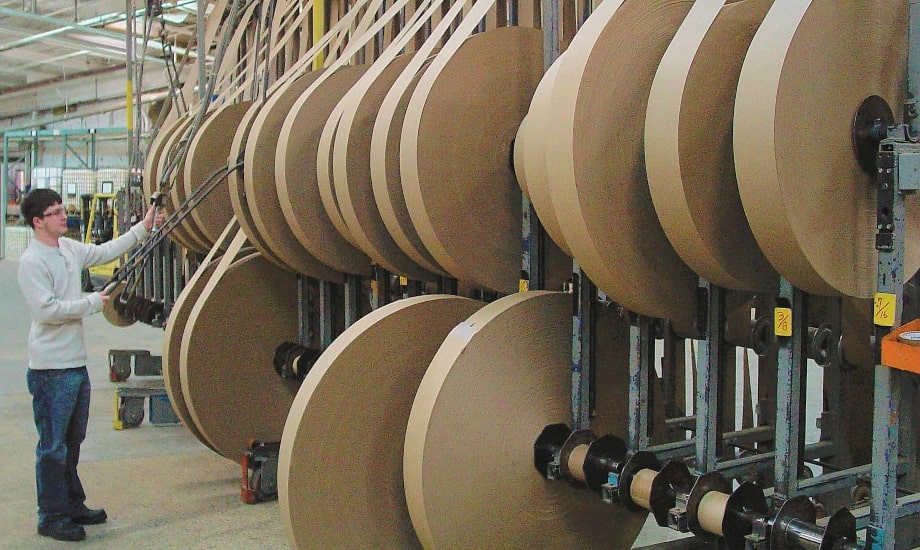Why Water Matters
As a global manufacturing company, Greif has a responsibility to minimize our water use and improve water quality, particularly in our most water intensive operations. Responsible water management reduces our demand for water as water scarcity and water costs are rising and ensures that water discharge from our facilities is treated and safe to protect the health of the communities in which we operate. Our water management practices simultaneously achieve these aims while creating operational efficiencies and minimizing regulatory risk.
الحوكمة
Only 1%
total water consumed in regions with high water baseline stress
لقد أتاحت لنا جهودنا في مجال جودة المياه تحقيق هدفنا المتمثل في خفض انبعاثات الكربون بنسبة 10% بحلول عام 2025.
Greif monitors Key Performance Indicators (KPIs) to ensure proper treatment of our wastewater. If a treatment incident occurs, the facility manager would observe a change to these KPIs, which initiates an investigation to determine the root cause and resolve the problem. When necessary, Greif engages third-party experts to support our investigations. For example, in 2020 Greif’s Tama mill experienced high biochemical oxygen demand (BOD) and nitrogen concentrations. Greif contracted with a third party to conduct a site inspection and recommend corrective actions. Based on their recommendations, we increased nutrient addition, instituted improved analytical testing to monitor nutrient levels and introduced chemical oxygen demand (COD) testing to receive faster feedback on potential issues.
While Greif’s water impact is predominately in our PPS operations, we take steps to curb water use across all our operations, particularly in water-stressed regions in Latin America, Africa and the Middle East. In these facilities, and across all our operations, we reduce water pressure where it is higher than needed, replace leaky valves and collect and use rainwater when possible. Our Global Industrial Packaging facility in Riyadh, Saudi Arabia implemented many such measures in an effort to reduce and recycle their wastewater, ultimately resulting in a 32 percent reduction in waste to landfill from their facility. Please see our يضيع page for more information on their achievement.
In 2021, we will develop standard environmental data dashboards across our mills to better understand and manage water and effluent, as well as energy data, and continue working to identify water efficiency opportunities.
الأهداف والتقدم
In 2017, Greif announced a 2020 goal of 10 percent reduction in kilograms of biochemical oxygen demand (BOD) per metric ton of production, from a 2014 baseline of 1.47, at legacy Greif mills. Our 2017 materiality process led to the creation of new 2025 goals and restating our BOD goal as a 2025 goal. Additionally, in 2021, we plan to create 2030 goals and targets in line with the American Forest and Paper Association.
In 2018, we reevaluated our historical water use and BOD data to confirm our baseline and assumptions to support continual improvement related to water. Through this process, we restated our 2014 BOD baseline to 1.40.
2025 Goal: Reduce BOD discharged in kilograms by 10 percent per metric ton of combined production from the Riverville and Massillon mills using the 2014 restated baseline by the end of fiscal year 2025.
Progress: Since 2017, we have reduced BOD per metric ton of production by 71.8 percent in our legacy Greif containerboard mills. Our significant progress against our BOD goal was enabled by the installation of a wastewater treatment facility at our Massillon mill. Completed in July 2017, the project led to modest improvements in 2017 and far surpassed expectations in 2018. These benefits continued to be realized in 2020.
In 2021, we will continue to track our progress in reducing BOD while controlling specific water use in our mills and reevaluate our goals to include both our legacy Greif mills and Caraustar mills that are now part of our organization. Additionally, in 2021, we will announce new water reduction targets for our mills.
Performance Data
WATER*
|
|
السنة المالية 2016 |
السنة المالية 2017 |
السنة المالية 2018 |
السنة المالية 2019 |
السنة المالية 2020 |
|---|---|---|---|---|---|
|
Water Withdrawal (Thousands of cubic meters)* |
8,420.2 |
9,666.3 |
9,360.8 |
13,864.4 |
12,936.6 |
|
المياه السطحية |
- |
9,242.7 |
8,630.0 |
10,266.8 |
10,132.0 |
|
المياه الجوفية |
- |
423.6 |
730.7 |
3,597.6 |
2,804.6 |
|
مياه الأمطار |
- | - | - | - | - |
|
مياه الصرف الصحي |
- | - | - | - | - |
|
Municipal Water† |
- | - | - | - | - |
|
Wastewater Discharge (Thousands of cubic meters)** |
7,961.4 |
8,983.2 |
9,316.2 |
12,403.92 |
11,935.1 |
|
نهر جيمس |
- |
8,788.8 |
8,907.1 |
7,949.5 |
8,375.0 |
|
مدينة ماسيلون |
- |
191.6 |
407.1 |
424.0 |
355.8 |
|
نهر توسكاراواس |
- |
2.8 |
2.0 |
2.5 |
8.8 |
|
Sweetwater Creek^ |
- |
- |
- |
0.0 |
0.0 |
|
Cobb County WWTP^ |
- |
- |
- |
844.9 |
855.0 |
|
Cincinnati Metropolitan Sewerage District^^ |
- |
- |
- |
37.6 |
40.6 |
|
Milwaukee Metropolitan Sewerage District^^ |
- |
- |
- |
349.0 |
335.9 |
|
Los Angeles County Sanitation District WWTF^^ |
- |
- |
- |
196.8 |
189.1 |
|
Three Mile Creek^ |
- |
- |
- |
0.0 |
- |
|
Village of Baltimore WWTF** |
- |
- |
- |
0.0 |
6.1 |
|
West Branch Paw Paw Creek** |
- |
- |
- |
697.1 |
581.4 |
|
San Jose-Santa Clara Regional WWTP^^ |
- |
- |
- |
288.1 |
334.2 |
|
Tacoma Central WWTP^^ |
- |
- |
- |
6.9 |
8.5 |
|
City of Fitchburg WWTP^ |
- |
- |
- |
322.6 |
309.0 |
|
Iowa River** |
- |
- |
- |
291.8 |
364.9 |
|
Cherry Lake** |
- |
- |
- |
597.8 |
550.4 |
|
Iowa Tributary** |
- |
- |
- |
58.0 |
78.6 |
|
Biochemical Oxygen Demand (Thousands of kg) |
1,050.4 |
890.4 |
204.2 |
3,508.3 |
3,457.1 |
|
إجمالي المواد الصلبة العالقة (كجم) |
546,857 |
465,098 |
349,003 |
1,224,442 |
1,045,928 |
|
الفوسفور (كجم) |
5,728 |
4,991 |
6,617 | 4,708 | 4,445 |
|
الإنتاج (طن متري) |
665,000 |
690,000 |
713,336 |
1,729,062 |
1,661,228 |
|
معدل الاستهلاك (م3/مت) |
12.7 |
14.0 |
13.1 |
8.02 |
7.79 |
ملحوظات:
- 2015 to 2018 data is from Greif’s two paper mills, one of which is located in Riverville, Virginia, and the other in Massillon, Ohio. Historically, these two paper mills accounted for more than 90% of Greif’s global water footprint. They draw from the James River and onsite water wells, respectively. 2019 data includes 12 former Caraustar mills that were acquired and integrated in 2019. All 2019 data is full year data. Quality of wastewater discharged from our mills meets permit requirements. No discharged water was used by another organization. WWTP = Wastewater Treatment Plant.
- تتضمن بيانات السنة المالية 2019 محطة معالجة مياه الصرف الصحي Mobile Wright Smith، والتي تم إغلاقها في عام 2020، وتمت إعادة صياغتها لتشمل بشكل صحيح تصريف West Branch Paw Paw Creek في السنة المالية 2019.
يتم معالجتها بالتوضيح الأولي والتوضيح الثانوي والتهوية قبل التفريغ المباشر.
تم معالجتها باستخدام معالجة مسبقة لمياه الصرف الصحي بما في ذلك إزالة الطلب البيوكيميائي للأكسجين القابل للذوبان.
تم معالجتها بمياه الصرف الصحي المعالجة مسبقًا بالمواد الصلبة فقط.
† Greif does not currently track withdrawal of municipal water.
|
استخدام المياه في المناطق التي تعاني من إجهاد مائي أساسي مرتفع أو مرتفع للغاية |
السنة المالية 2020 |
|---|---|
|
سحب المياه (بالآلاف الأمتار المكعبة) |
170.4 |
|
نسبة إجمالي سحب المياه |
1% |
|
المياه المستهلكة (بالآلاف الأمتار المكعبة) |
162.7 |
|
نسبة إجمالي المياه المستهلكة |
1% |
Improving Our Wastewater
In 2017, Greif’s Massillon, Ohio mill completed construction of a water treatment facility to significantly reduce the biological oxygen demand (BOD) of the plant’s discharge water before being returned to the municipal treatment plant. High BOD levels promote bacteria growth, release odors and must be controlled using chemicals. Since installing the treatment facility, we reduced BOD discharged to the municipal system by over 96 percent, contributing to our 2025 BOD reduction goal. This also eliminated several chemicals that were previously needed to control bacteria.

Water Reduction at Our Baltimore, Ohio Mill
In 2020, Greif’s Baltimore, Ohio mill transitioned from direct discharge of treated wastewater to a local creek to discharging pretreated wastewater to a local water treatment facility that uses a state-of-the-art membrane treatment system to further treat water. This shift both reduced overall water discharge and supported returning cleaner water to the community. Greif engaged with local and state governments over the course of multiple years to design and approve the project, which was approved in 2019 and completed in October 2020. The project will reduce water consumption by 550,000 m3 per year. The community benefits from a cleaner surface water since several tons per year of biological oxygen demand and total suspended solids were also removed from the local creeks because of this transition.

أبرز ما يميز الاستدامة
Only 1%
Total water consumed in regions with high water baseline stress
لقد أتاحت لنا جهودنا في مجال جودة المياه تحقيق هدفنا المتمثل في خفض انبعاثات الكربون بنسبة 10% بحلول عام 2025.



